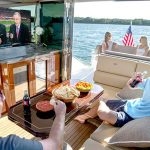
If your boat primarily stays in a single area and you are interested in watching programs on the major networks or local channels, broadcast TV can make great sense for you. Reception will vary depending on your location and the antenna on your boat, but these days just about all over the air broadcasts are in HD.
If you’re interested in recording over-the-air TV you will need some sort of digital video recorder (DVR). You can buy a device like a Tivo Roamio or Tablo DVR or run software like Plex, Emby, or Silicon Dust DVR. These software options use over the air tuners like Silicon Dust’s HDHomeRun line of tuners to tune in available programming and record it. Those recordings are then available on a wide range of devices including PCs, tablets, phones, Roku, FireTV, AppleTV and many smart TVs. When these packages work they’re a great option. Reliability has proven to be challenging in my time using them.
Starting with broadcast TV and then complementing that with streaming services can be among the most cost effective options.
Satellite TV

For many, satellite TV on their boat is the ultimate way to receive television. Stabilized satellite dishes are capable of receiving TV anywhere within a provider’s broadcast footprint underway, at a dock, or at anchor. Satellite TV services are all pay services so a subscription is required with the provider. In the US those providers are either Dish Network or DirecTV.
There are two basic bands satellite providers use, Ku and Ka. Originally all the providers used Ku and all the stabilized in motion dishes were built for this band. As part of the move to HD DirecTV migrated nearly all of their programming to Ka. The Ka-band presents a smaller target in space and requires much higher precision in the stabilization and tracking systems within the dish. The two least expensive options for receiving Ka are the KVH TracVision HD-7 with a suggested retail of $12,995 and the Intellian S6HD with a suggested retail of $9,995. Ku dishes start with Intellian’s i2 which lists for $2,695 and KVH’s TracVision TV1 which also lists for $2,695.
With Dish Network you will be able to receive HD broadcasts on a Ku dish but the programming comes from three different satellites. So, if you have multiple TVs on the boat they all must watch TV from the same satellite at the same time.
All satellite providers offer receivers with DVRs built in so you have the option to record what you receive.
AT&T, who bought DirecTV a few years ago, has said they hope to migrate their satellite subscribers to DirecTV Now, their streaming TV service, by 2020. I’m not sure they stand much chance of making that goal but, at least for me, it casts some doubt on making a nearly $10,000 investment on an in motion dish capable of receiving Ka band broadcasts.
KVH has published a great comparison between Dish and DirecTV for boaters. It’s available here and shows the differences as well as coverage maps and approximate limits of coverage by dish size. Among the factors called out in this guide is that both satellite providers in the U.S. use spot-beam technology to deliver your local networks. Spot-beams are directional signals from the satellites that can only be received within a few hundred miles of the intended area. You may be able to receive New York or Los Angeles locals but receiving approval to do this can be a maze of forms and approvals.


